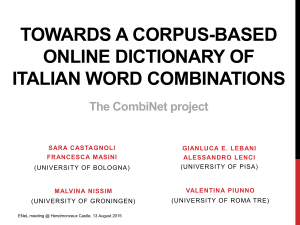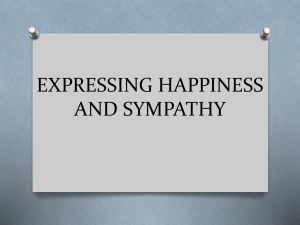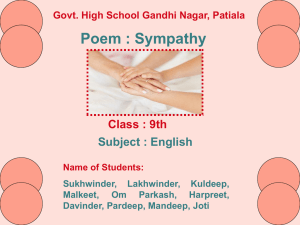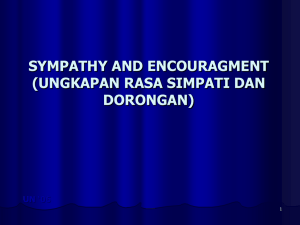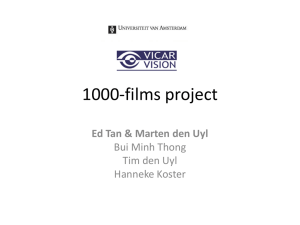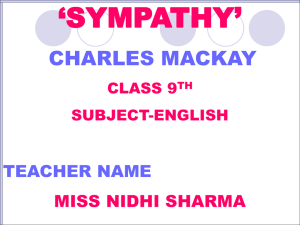SYMPAThy: Towards a comprehensive approach to
advertisement
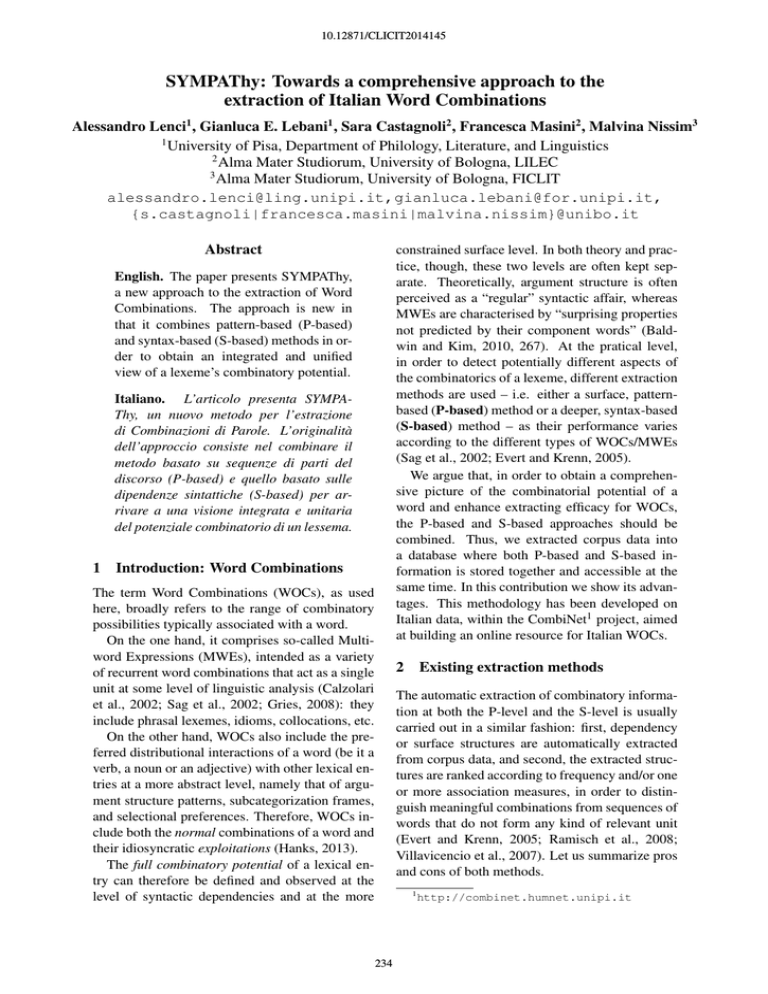
10.12871/CLICIT2014145
SYMPAThy: Towards a comprehensive approach to the
extraction of Italian Word Combinations
Alessandro Lenci1 , Gianluca E. Lebani1 , Sara Castagnoli2 , Francesca Masini2 , Malvina Nissim3
1
University of Pisa, Department of Philology, Literature, and Linguistics
2
Alma Mater Studiorum, University of Bologna, LILEC
3
Alma Mater Studiorum, University of Bologna, FICLIT
alessandro.lenci@ling.unipi.it,gianluca.lebani@for.unipi.it,
{s.castagnoli|francesca.masini|malvina.nissim}@unibo.it
Abstract
constrained surface level. In both theory and practice, though, these two levels are often kept separate. Theoretically, argument structure is often
perceived as a “regular” syntactic affair, whereas
MWEs are characterised by “surprising properties
not predicted by their component words” (Baldwin and Kim, 2010, 267). At the pratical level,
in order to detect potentially different aspects of
the combinatorics of a lexeme, different extraction
methods are used – i.e. either a surface, patternbased (P-based) method or a deeper, syntax-based
(S-based) method – as their performance varies
according to the different types of WOCs/MWEs
(Sag et al., 2002; Evert and Krenn, 2005).
We argue that, in order to obtain a comprehensive picture of the combinatorial potential of a
word and enhance extracting efficacy for WOCs,
the P-based and S-based approaches should be
combined. Thus, we extracted corpus data into
a database where both P-based and S-based information is stored together and accessible at the
same time. In this contribution we show its advantages. This methodology has been developed on
Italian data, within the CombiNet1 project, aimed
at building an online resource for Italian WOCs.
English. The paper presents SYMPAThy,
a new approach to the extraction of Word
Combinations. The approach is new in
that it combines pattern-based (P-based)
and syntax-based (S-based) methods in order to obtain an integrated and unified
view of a lexeme’s combinatory potential.
Italiano. L’articolo presenta SYMPAThy, un nuovo metodo per l’estrazione
di Combinazioni di Parole. L’originalit`a
dell’approccio consiste nel combinare il
metodo basato su sequenze di parti del
discorso (P-based) e quello basato sulle
dipendenze sintattiche (S-based) per arrivare a una visione integrata e unitaria
del potenziale combinatorio di un lessema.
1
Introduction: Word Combinations
The term Word Combinations (WOCs), as used
here, broadly refers to the range of combinatory
possibilities typically associated with a word.
On the one hand, it comprises so-called Multiword Expressions (MWEs), intended as a variety
of recurrent word combinations that act as a single
unit at some level of linguistic analysis (Calzolari
et al., 2002; Sag et al., 2002; Gries, 2008): they
include phrasal lexemes, idioms, collocations, etc.
On the other hand, WOCs also include the preferred distributional interactions of a word (be it a
verb, a noun or an adjective) with other lexical entries at a more abstract level, namely that of argument structure patterns, subcategorization frames,
and selectional preferences. Therefore, WOCs include both the normal combinations of a word and
their idiosyncratic exploitations (Hanks, 2013).
The full combinatory potential of a lexical entry can therefore be defined and observed at the
level of syntactic dependencies and at the more
2
Existing extraction methods
The automatic extraction of combinatory information at both the P-level and the S-level is usually
carried out in a similar fashion: first, dependency
or surface structures are automatically extracted
from corpus data, and second, the extracted structures are ranked according to frequency and/or one
or more association measures, in order to distinguish meaningful combinations from sequences of
words that do not form any kind of relevant unit
(Evert and Krenn, 2005; Ramisch et al., 2008;
Villavicencio et al., 2007). Let us summarize pros
and cons of both methods.
1
234
http://combinet.humnet.unipi.it
2.1
P-based approach
2.2
S-based approach
S-based methods are based on dependency relations extracted from parsed corpora. They offer
the possibility to extract co-occurrences of words
in specific syntactic configurations (e.g. subjectverb, verb-object etc.) irrespective of their superficial realizations, i.e. generalizing over syntactic
flexibility and interrupting material. S-based extraction methods thus have two major advantages.
First, by moving away from surface forms, they
can help account for the complexity and the syntactic variability that some WOCs – like the V+N
combination aprire una discussione above – might
exhibit. Second, by taking into account the dependency between elements, they minimise the risk of
extracting unrelated words (Seretan et al., 2003).
As a consequence, they are particularly useful to
extract “abstract” structures such as lexical sets,
i.e. lists of fillers in given slots (e.g. the most
prototypical objects of a verb), argument structure
patterns and subcategorization frames.
However, precisely because S-based methods
abstract away from specific constructs and information (word order, morphosyntactic features, interrupting material, etc.), they do not consider how
exactly words are combined. Thus, the regular
phrase gettare acqua su un fuoco ‘throw water on a
fire’ and the structurally similar idiom gettare acqua sul fuoco ‘defuse’ would be treated equally, on
the basis of the combination of throw-water-fire.
Also, S-based approaches cannot distinguish
frequent “regular” combinations (e.g. gettare la
sigaretta ‘throw the sigarette’) from idiomatic
combinations that have the very same syntactic
structure (e.g. gettare la spugna lit. throw the
sponge ‘throw in the towel’). Statistical association measures alone are not able to discriminate
between them as both sigaretta and spugna are
likely to appear among the preferred fillers of the
object slot of gettare.
P-based methods exploit shallow (POS-)patterns,
and are often employed for extracting WOCs. The
specification of POS-patterns is a necessary step
to obtain a better set of candidate structures with
respect to (adjacent) unspecified n-grams. However, despite any attempt to obtain a comprehensive list of language-appropriate patterns (Nissim
et al., 2014), not every extracted combination is
a WOC, even after association measures are applied. The string may be part of a larger WOC (see
stesso tempo ‘same time’, which is a very frequent
bigram in itself, but is in fact part of the larger allo
stesso tempo ‘at the same time’), or it may contain
a WOC plus some extra element (e.g. anno/i di
crisi economica ‘year(s) of economic crisis’, containing crisi economica ‘economic crisis’). Overall, however, the P-based method yields satisfactory results for relatively fixed, adjacent, and short
(2-4 words) WOCs (e.g. alte sfere ‘high society’).
Some WOCs, however, especially verbal ones2 ,
allow for higher degrees of syntactic flexibility (e.g.
passivization, dislocation, variation/addition/dropping of a determiner, internal
modification by means of adjectives/adverbs, etc.)
(Villavicencio et al., 2007) and/or display a complexity which is difficult to capture without resorting to syntactic information. A collocation like
aprire una discussione ‘start a discussion’, for instance, is syntagmatically non-fixed in a number
of ways: the determiner can vary (aprire una/la
discussione ‘start a/the discussion’), the object can
be modified (aprire una lunga e difficile discussione ‘start a long and difficult discussion’), and
passivization is allowed (la discussione e` stata
aperta ‘the discussion was started’). This would
require taking into account and specifying all possible variations a priori. Similarly, some idioms
can be very difficult to capture with POS-patterns
because of their length and complexity, which is
hardly “generalizable” into meaningful POS sequences (e.g.: dare un colpo al cerchio e uno alla
botte lit. give a blow to the ring and one to the barrel ‘run with the hare and hunt with the hounds’).
Last but not least, P-based approaches are not able
to address more abstract combinatory information
(e.g. argument structures) and are thus typically
limited to MWEs.
3
SYMPAThy: A unified approach
P-based and S-based methods for WOC analysis
are in fact highly complementary. In our view, the
existing dualism does not reflect the fact that all
these combinatory phenomena are interconnected
with one another, and that there is a very intricate
continuum that links fixed and flexible combinations, compositional and totally idiomatic ones.
In order to represent the full combinatory potential of lexemes, and in an attempt to disentan-
2
In Italian, verbal MWEs are less fixed than nominal ones
(Voghera, 2004), even though variability is a thorny issue for
nominal MWEs, too (Nissim and Zaninello, 2013).
235
naio getta l’ancora ‘the sailor throws the anchor’, for two different TLs: gettare ‘throw’
and ancora ‘anchor’. In this representation,
the terminal nodes are labeled with patterns
of the form lemma-pos|morphological
features|distance from target. For instance, the label il-r|sm|-2 should be read as
an instance of the singular masculine form (sm)
of the lemma il ‘the’, that is an article (r) linearly
placed two tokens on the left of TL3 .
The structural information encoded by our patterns, moreover, abstracts from the one-to-one dependency relations identified by the parser in order to build macro-constituents somehow reminiscent of the tree structure typical of phrase
structure grammars. Such macro-constituents represent meaningful chunks of linguistic units, in
which one element (the ‘head’, marked by a superscript H ) is prominent with respect to the others. Non-head elements include intervening elements, like determiners, auxiliaries and quantifiers, whose presence is crucial to determine how
fixed a linguistic construction is (and that is usually neglected in S-based approaches), and whose
linear placement should be known a priori in a Pbased perspective. This information is vital in distinguishing idioms, like gettare acqua sul fuoco
(see Section 2.2), from otherwise identical compositional expressions like gettare acqua su quel
grande fuoco (‘throw water on that big fire’).
Finally, the contrast between the two patterns
reported in Figure 1 gives a measure of how
much the SYMPAThy data representation format
is target-dependent. On the one hand, both the
syntactic annotation and the linear order are represented with respect to the TL: see the inverse OBJ 1 dependency in the ancora-based pattern, as well
as the rationale of the indexing encoding the linear
positions of terminal elements.
On the other hand, only the part of the sentence
that is relevant to characterize the combinatorial
behavior of the TL is extracted. In the preliminary work presented here, such a relevant portion
includes all the constituents that are directly or indirectly governed by TL (e.g. the object of a verb
together with the prepositional phrases modifying
its nominal head), and the constituent that governs
TL, thus encoding inverse relations like the OBJ -1
dependency in the lower pattern of Figure 1.
gle this continuum of WOCs, we propose to adopt
a unified approach, whose theoretical premises lie
in a constructionist view of the language architecture. In Construction Grammar, the basic unit of
analysis is the Construction, intended as a conventionalized association of a form and a meaning
that can vary in both complexity and schematicity
(Fillmore et al., 1988; Goldberg, 2006; Hoffmann
and Trousdale, 2013). Therefore, Constructions
span from specific structures such as single words
(Booij, 2010) to complex, abstract structures such
as argument patterns (Goldberg, 1995), in what
is known as the lexicon-syntax continuum, which
comprises MWEs and other types of WOCs.
3.1
SYntactically Marked PATterns
We implemented this view in a distributional
knowledge base, SYMPAThy (SYntactically
Marked PATterns), built by extracting from a
dependency-parsed corpus all the occurrences
of a set of lemmas and processing them so as to
obtain an integrated representation of the kinds
of combinatorial information usually targeted in
S-based and P-based methods, albeit separately.
The ultimate goal of our extraction algorithm is
to filter and interpret the linguistic annotation provided by a pipeline of NLP tools and to represent
it with a data format that allows for the simultaneous encoding of the following linguistic information, for any terminal node that depends on a given
target lemma TL or on its direct governor:
• its lemma;
• its POS tag;
• its morphosyntactic features;
• its linear distance from the TL;
• the dependency path linking it to TL.
By building on an automatically annotated corpus, the actual implementation of the SYMPAThy extraction algorithm is largely dependent on
the properties of the specific linguistic annotation tools exploited. Here we report examples
extracted from a version of the “la Repubblica”
corpus (Baroni et al., 2004) that has been POS
tagged with the Part-Of-Speech tagger described
in Dell’Orletta (2009) and dependency parsed
with DeSR (Attardi and Dell’Orletta, 2009).
Figure 1 shows the different patterns that
can be extracted from the sentence il mari-
3
For a description of the tagsets used to annotate the corpus, see: http://medialab.di.unipi.it/wiki/
Tanl_Tagsets.
236
[T GT [SU BJ il-r|sm|-2 marinaio-s|sm|-1H ] gettare-v|s3ip|0H
[OBJ il-r|sn|1 ancora-s|sn|2H ] ]
[OBJ−1 gettare-v|s3ip|-2H [T GT il-r|sn|-1 ancora-s|sn|0H ] ]
Figure 1: LEFT: dependency tree4 for the sentence il marinaio getta l’ancora ‘the sailor throws the
anchor’; RIGHT: SYMPAThy patterns for the TLs gettare ‘throw’ (above) and ancora ‘anchor’ (below).
3.2
A sympathetic example
ing superficial variations due to the presence of interrupting material, typically adverbs.
Cases with acqua in the object position present
a more articulated picture. Half of them (53.5%)
are instances of the rigid idiomatic expression
TL acqua sul fuoco ‘defuse’. As for the remaining cases, even if there is a strong preference for
realizing TL and the object one next to the other,
with no morphological variation (84%), there is
substantial variability in the number, type and
filler of the indirect complement (36% of the remaining cases are instances of a subcategorization
frame different from the simple transitive one).
When the object slot is filled by ombra, finally,
the constructions appear to be freer. Even if there
is a strong preference (40% of the cases) for the idiom TL (una|la) ombra su, roughly meaning ‘cast
a shadow on’, dimensions of variability include
the presence/absence of a determiner, its type, and
the optional presence of intervening tokens (e.g.
adverbs/adjectives) between TL and the object.
Overall this brief example shows how P-based
and S-based ideas can be used together to obtain
a better description of the combinatoric behavior
of lexemes, thus advocating for the usefulness of
a resource like SYMPAThy that is able to bridge
between the aforementioned approaches.
Here follows a small example showing how such
a representation can be used to integrate S-based
and P-based approaches. We extracted from our
parsed version of the “la Repubblica” corpus all
the SYMPAThy patterns featuring a transitive construction governed by the TL gettare ‘throw’. In a
S-based fashion, we ranked the nominal heads filling the object position and found that the most frequent object fillers of gettare are spugna ‘sponge’,
acqua ‘water’ and ombra ‘shadow’.
By taking into account the whole subcategorization frame in which these <T L, obj> pairings occur, other interesting patterns emerge. When occurring with acqua, TL is often associated with a
complement introduced by the preposition su and
headed by the noun fuoco ‘fire’. Another salient
pattern displays TL with the object ombra and an
indirect complement introduced by su and filled
by a nominal head other than fuoco.
At the S-level only, it is difficult to guess what
the status of these constructions is. Are they compositional or somehow fixed? If the latter, in
which way and to what extent is their variation
limited? The P-based side of the SYMPAThy data
format comes in handy to address such issues.
Here crucial pieces of information are the presence/absence of intervening material between TL
and the heads of the governed constituents, how
variable is the morphological behavior of the relevant lexical elements and to what extent they are
free to be superficially realized with respect to TL.
By looking at this information, we can see that
the strong association gettare + obj:spugna is due
to the high frequency of the idiomatic expression
TL la spugna ‘throw in the towel’. Indeed, 98%
of the patterns are linearly and morphologically
fixed, with most of the remaining cases (1.7%) be-
4
Conclusions
In this paper we presented SYMPAThy, a new
method for the extraction of WOCs that exploits
a variety of information typical of both P-based
and S-based approaches. Although SYMPAThy
was developed on Italian data, it can be adapted to
other languages. In the future, we intend to exploit
this combinatory base to model the gradient of
schematicity/productivity and fixedness of combinations, in order to develop an “WOC-hood” indicator to classify the different types of WOCs on
the basis of their distributional behavior.
4
Plotted with DgAnnotator: http://medialab.di.
unipi.it/Project/QA/Parser/DgAnnotator/
237
Acknowledgments
Stefan Th. Gries. 2008. Phraseology and linguistic
theory: a brief survey. In Sylviane Granger and
Fanny Meunier, editors, Phraseology: an interdisciplinary perspective, pages 3–25. John Benjamins,
Amsterdam & Philadelphia.
This research was carried out within the CombiNet
project (PRIN 2010-2011 Word Combinations in
Italian: theoretical and descriptive analysis, computational models, lexicographic layout and creation of a dictionary, n. 20105B3HE8), coordinated by Raffaele Simone (Roma Tre University)
and funded by the Italian Ministry of Education,
University and Research (MIUR).
Patrick Hanks. 2013. Lexical Analysis: Norms and
Exploitations. MIT Press, Cambridge, MA.
Thomas Hoffmann and Graeme Trousdale, editors.
2013. The Oxford Handbook of Construction Grammar. Oxford University Press, Oxford.
Malvina Nissim and Andrea Zaninello. 2013. Modeling the internal variability of multiword expressions through a pattern-based method. ACM Trans.
Speech Lang. Process., 10(2):1–26.
References
Giuseppe Attardi and Felice Dell’Orletta. 2009. Reverse revision and linear tree combination for dependency parsing. In Proceedings of NAACL 2009,
pages 261–264.
Malvina Nissim, Sara Castagnoli, and Francesca
Masini. 2014. Extracting mwes from italian corpora: A case study for refining the pos-pattern
methodology. In Proceedings of the 10th Workshop
on Multiword Expressions (MWE), pages 57–61.
Timothy Baldwin and Su Nam Kim. 2010. Multiword expressions. In Nitin Indurkhya and Fred J.
Damerau, editors, Handbook of Natural Language
Processing, Second Edition. CRC Press, Taylor and
Francis Group, Boca Raton, FL.
Carlos Ramisch, Paulo Schreiner, Marco Idiart, and
Aline Villavicencio. 2008. An Evaluation of Methods for the Extraction of Multiword Expressions.
In Proceedings of the LREC Workshop MWE 2008,
pages 50–53.
Marco Baroni, Silvia Bernardini, Federica Comastri,
Lorenzo Piccioni, Alessandra Volpi, Guy Aston, and
Marco Mazzoleni. 2004. Introducing the La Repubblica Corpus: A Large, Annotated, TEI(XML)Compliant Corpus of Newspaper Italian. In Proceedings of LREC 2004, pages 1771–1774.
Ivan A. Sag, Timothy Baldwin, Francis Bond, Ann
Copestake, and D. Flickinger. 2002. Multiword expressions: A pain in the neck for NLP. In Proceedings of CICLing 2002, pages 1–15.
Geert Booij. 2010. Construction morphology. Oxford
University Press, Oxford.
Violeta Seretan, Luka Nerima, and Eric Wehrli. 2003.
Extraction of multi-word collocations using syntactic bigram composition. In Proceedings of RANLP03, pages 424–431.
Nicoletta Calzolari, Charles J. Fillmore, Ralph Grishman, Nancy Ide, Alessandro Lenci, Catherine
MacLeod, and Antonio Zampolli. 2002. Towards
best practice for multiword expressions in computational lexicons. In Proceedings of LREC 2002,
pages 1934–1940.
Aline Villavicencio, Valia Kordoni, Yi Zhang, Marco
Idiart, and Carlos Ramisch. 2007. Validation and
evaluation of automatically acquired multiword expressions for grammar engineering. In Proceedings
of EMNLP-CoNLL 2007, pages 1034–1043.
Felice Dell’Orletta. 2009. Ensemble system for Partof-Speech tagging. In Proceedings of EVALITA
2009.
Miriam Voghera. 2004. Polirematiche. Linguistica
Pragensia, 67(2):100–108.
Stefan Evert and Brigitte Krenn. 2005. Using small
random samples for the manual evaluation of statistical association measures. Computer Speech &
Language, 19(4):450–466. Special issue on Multiword Expression.
Charles J. Fillmore, Paul Kay, and Mary Catherine
O’Connor. 1988. Regularity and idiomaticity in
grammatical constructions: the case of let alone.
Language, 64(3):501–538.
Adele Goldberg. 1995. Constructions. A Construction
Grammar Approach to Argument Structures. The
University of Chicago Press, Chicago.
Adele Goldberg. 2006. Constructions at work. Oxford
University Press, Oxford.
238
